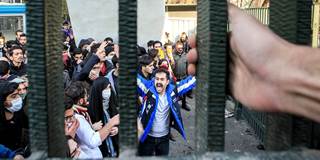Iran's protests, fueled by the rising cost of living and widening economic and social disparities, have quickly morphed into a repudiation of the regime itself. While much of the anger has been directed at the conservative clerical establishment, reformists have as much at stake as their hardline rivals.
LONDON – The rapid spread of civil unrest in Iranian towns and cities that began in late December has taken nearly everyone – President Hassan Rouhani’s reform-minded government, many citizens, and observers – by surprise. Starting in Mashhad, a large religious city in the country’s northeast and a stronghold of Rouhani’s conservative foes, the protests engulfed a number of smaller towns with a speed and ferocity that few could have predicted.

LONDON – The rapid spread of civil unrest in Iranian towns and cities that began in late December has taken nearly everyone – President Hassan Rouhani’s reform-minded government, many citizens, and observers – by surprise. Starting in Mashhad, a large religious city in the country’s northeast and a stronghold of Rouhani’s conservative foes, the protests engulfed a number of smaller towns with a speed and ferocity that few could have predicted.